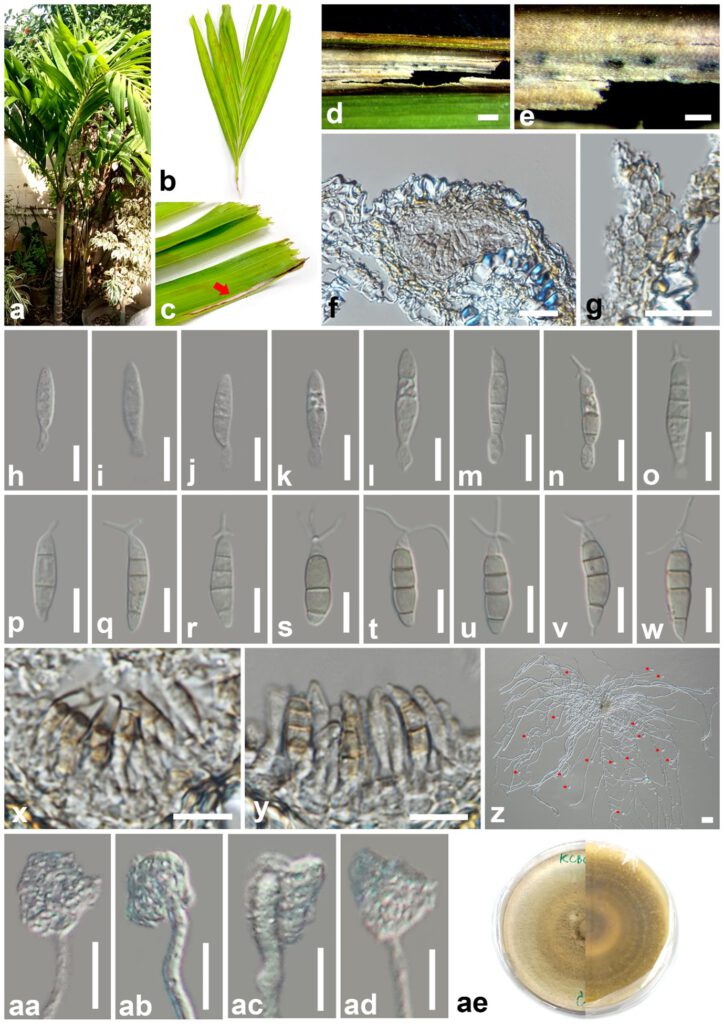Bartalinia adonidiae Konta & K.D. Hyde, in Konta, Tibpromma, Karunarathna, Samarakoon, Steven, Mapook, Boonmee, Senwanna, Balasuriya, Eungwanichayapant & Hyde, Mycosphere 14(1): 120 (2023)
Index Fungorum number:IF 559714; MycoBank number: MB 559714; Facesoffungi number: FoF 10823.
Etymology – Refers to the host genus Adonidia.
Holotype – MFLU 22-0086.
Saprobic or on dead part in living leaves of Adonidia merrillii. Sexual morph: Undetermined. Asexual morph: Coelomycetous. Conidiomata 35–60 × 55–95 µm (x̅ = 55 × 70 µm, n = 10), subglobose to lenticular, visible as dark grey to black, immersed, slightly raised, solitary to gregarious, uniloculate. Conidiomatal walls 10–14 µm (x̅ = 12 µm, n = 10), slightly thick-walled, of equal thickness, comprising several cell layers of light brown to brown, pseudoparenchymatous cells of textura angularis, paler towards the inner layers. Conidiophores arising from the inner cavity reduced to conidiogenous cells. Conidiogenous cells 3–7 × 1.8–3.8 µm (x̅ = 5 × 3 µm), enteroblastic, annellidic, integrated, hyaline, ampulliform to subcylindrical, or obclavate, aseptate, smooth-walled. Conidia 14–21.85 × 3.65–6.2 µm (x̅ = 17.25 × 4.77 µm, n = 100), cylindrical to inequilateral, straight to slightly curved, 2–4-septate, constricted at the septa, with the longest cell at the second from the base, bearing appendages; basal cell 2.7–4.3 µm long (x̅ = 3.6 µm), obconic, truncate at base, hyaline, thin and smooth-walled, second cell from the base 30.5–4.1 µm long (x̅ = 3.57 µm), pale yellowish, third cell 2.5–4.36 µm long (x̅ = 3.54 µm), pale yellowish, fourth cell 3.91–5.95 µm long (x̅ = 5.08 µm), pale yellowish, apical cell 2.56–4.34 µm long (x̅ = 3.36 µm), conical, hyaline and smooth-walled, forming three-branched tubular, flexuous, 6–18 µm long (x̅ = 10 µm) apical appendages, basal appendages 1.28–2.94 µm long (x̅ = 1.95 µm), single, absent at immature state, tubular, unbranched, centric. Appressoria irregular, hyaline, rough-walled, 5–16.8 × 7–20 µm (x̅ = 11 × 11.2 µm, n = 50).
Culture characteristics – Colonies on MEA. Colonies from above; white fluffy at the beginning, dense, circular, turning yellow-brown from the middle, becoming red-brown to green-brown, and creamy brown towards the edge, entire margin at maturity. Colonies from below olivaceous-green, white at the entire edge with circular layers.
Material examined – Thailand, Kanchanaburi Province, on dead parts of living leaves of Adonidia merrillii (Arecaceae), 8 September 2018, Machima Saengket, KCB03 (MFLU 22-0086, holotype).
GenBank numbers – MFLU 22-0086B, C, LSU: ON650681, ON650682; ITS: ON650703, ON650704.
Notes – The taxonomic identification of the fungal genus Bartalinia reveals that it is a monophyletic clade of saprophytes associated with leaf spots on the leaves of various hosts (Matsushima 1987, Pinggen et al. 2000, Li et al. 2002, Andrianova et al. 2007, Liu et al. 2019, Phookamsak et al. 2019, Tibpromma et al. 2020). In the BLASTn NCBI GenBank database search of LSU, and ITS sequences, Bartalinia adonidiae (strains MFLU 22-0086B, C) are mostly similar to B. robillardoides (CBS 122705) (strains B) and B. pondoensis (CBS 125525) (strains C) with 99.46%, and 99.76% (LSU) and to B. pondoensis (CMW 31067) (strains B, C) with 99.33%, 99.17% (ITS) similarity. Based on the multi-gene analyses, our isolates showed close affinities to B. kunmingensis but were different in shape, septation, and size of conidia (Phookamsak et al. 2019). Bartalinia adonidiae differs from B. kunmingensis in sub-globose to lenticular conidiomata, cylindrical to inequilateral conidia, 2–4-septate, constricted at the septa, shorter basal cells, the second cell from the base, the third cells, the fourth cells, and the basal appendages are 2.0–3.2 µm vs. 2.5–4 µm, 3.3–4.6 µm vs. 6.5–8 µm, 2.5–3.3 vs. 4–5.5 µm, 2.4–3.2 vs. 4–5.5(–6) µm, 1.3–3 vs. 5–6 µm, respectively, and overlapping in size of the apical appendages (6–18 vs. 10–20 µm), while B. kunmingensis has globose to sub-globose conidiomata, cylindrical to sub-cylindrical, conidia 4-septate, not constricted at the septa (Phookamsak et al. 2019). Only B. robillardoides has been recorded, associated with Borassus flabellifer (Arecaceae) in India (Mathur 1979). Thus, we introduce our collection as a new species, Bartalinia adonidiae, from the dead part of the living leaves of Adonidia merrillii (Arecaceae) in Thailand. This is the first report of an appressorium structure for this genus.

Figure 1 – Bartalinia adonidiae (MFLU 22-0086, holotype). a Adonidia merrillii tree. b, c Leaf of Adonidia merrillii. d, e Conidiomata on host substrate. f Vertical section of conidioma. g Conidioma wall. h–o, x, y Conidiogenous cells with conidia. p–w Conidia. z Germinated conidium with appressoria pointed by red arrow. aa–ad Appressoria. ae Colony on MEA. Scale bars d = 500 μm, e = 200 μm, f, g, z = 20 μm, h–y, aa–ad = 10 μm.
